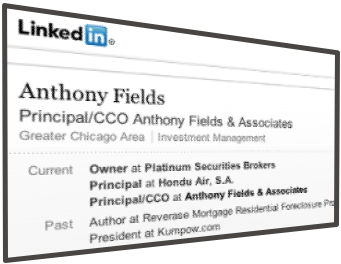
Duped by Social Media: 6 Questions You Should Ask when Using LinkedIn

Last week, the SEC accused Anthony Fields’ of marketing fraudulent securities on LinkedIn. This is perhaps the most serious example yet of the conflict between social media and SEC / FINRA regulatory guidelines designed to protect and serve investors of all types. The accusation indicates that Anthony Fields used LinkedIn and other social media networking websites to lure investors by offering more than $500 billion in fake securities. The SEC said Fields provided false and misleading information about clients, assets under management, and even the history of his firm’s business. Fields held himself out as a broker-dealer even though he never properly registered with the SEC, the agency said.
LinkedIn members use unregulated, member-created groups to network with other LinkedIn members with similar interests. Most of these groups are open to all, and none require a background check or other accreditation, critical credentials for safely functioning private financial markets.
These activities happen outside the reach of any active compliance apparatus verifying the quality, identity or validity of the marketed investment opportunities or the individual advertising them. Since these are open and unvetted forums, their use in the context of selling equity or debt securities of any kind falls into unsanctioned ground according to the SEC’s general solicitation regulations.
If you are a deal professional and you wish to use LinkedIn in compliance of federal regulations, you’ll want to hold off on using LinkedIn Groups to solicit interest from investors of any kind.
LinkedIn can still be used to great success in developing relationships with relevant professionals. To do this most efficiently and productively, use the following six questions to help you measure a member’s credibility and level of engagement with LinkedIn:
1. Does the member have a robust network? Make sure you reach out to those LinkedIn members who have relevant connections and a credible work history in the deal business, and who also maintain a fairly complete profile (if it looks like an empty shell, it probably means they don’t use LinkedIn and won’t respond to you).
2. Are you connected to the deal professional by a second or third degree? If so, who are your mutual connections and how well do you know them? Do you trust them? Many LinkedIn members are open networkers who accept any invitation to connect. These are people with too much time on their hands.
3. Are his/her connections accessible? If so, browse their connections and see if they make sense. Many personal networks are made up of connections in a similar industry or role. If the connections seem random, they aren’t likely a committed deal professional and more likely a gold-chaser.
4. Do you share a group? An open group? Open groups are those that anyone can join and usually turn into a cesspool of useless and incoherent dialog.
5. Does the deal professional’s company or employer of record have a company profile on LinkedIn which links to their company website? This is always a good indicator that they’re committed and serious about using modern internet tools to become more successful deal professionals.
6. Does the advisor list his/her deal history on their profile or website? Can you confirm they were in fact participants in any deal they claim to be a part of?
Because online social networks and social media have become more pervasive and frequently used methods of business communication, we wrote another article that reviews steps and notices FINRA has created to provide guidance for deal professionals working in the private markets.